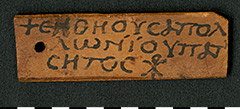T.Berl.Möller 125 (ÄM 11843)
It was an ancient Egyptian custom to provide mummies with a small tablet that gave information about the deceased. At first, one would not expect such a mummy label for a Christian. However, several examples have survived from late antique Egypt. The mummy label presented here is one of them.
Mummy labels are small wooden tablets with at least one hole through which a string could be pulled to attach the label to the mummy. The main purpose of the mummy labels was identification of the embalmed corpses. Thus, these wooden tablets inscribed in Greek and/or Demotic gave the name of the deceased and usually also the names of the parents and grandfather. This was often followed by a statement of the age of the deceased. Occasionally, the date of death and an origin were also mentioned. Sometimes we even learn something about the profession of the deceased from these usually very short texts. Many mummy labels also contained freight instructions for the mummy, giving information about costs, places of dispatch and destination, and details of the transport. Most demotic mummy labels also bear religious formulas that are also found on grave stelae, such as the invocation to the Ba ’soul‘ to be permanently alive. The mummy labels thus represented a kind of substitute for a gravestone, which would have been too expensive for most people. They belonged exclusively to the deceased of the lower class.
Attaching such wooden tablets to mummies is a custom that appeared in Egypt from the 1st century AD at the latest and remained popular in the following centuries. The mummy shield presented here is one of the latest examples of these texts and is dated to the 4th century AD. It was found in the necropolis of Akhmim, the ancient Panopolis, and came into the Berlin Collection in 1894.
Like the vast majority of mummy labels, this one has a landscape format. Equally typical are the brevity of the text and the information about the deceased, which is limited almost exclusively to the essential details. The name of the deceased, the name of his father and the name of his grandfather are given in a neat but somewhat awkward script: „(Mummy) of Psentheus, (son) of Apollonius (and grandson) of Patses“. It is striking that the deceased has an Egyptian name, his father a Greek name and his grandfather again a very rare Egyptian name. The Christ monogram at the end of the text, composed of the Greek letters chi and rho written one inside the other, is also remarkable and was not in use in this form until the 4th century AD. It identifies the deceased as a Christian.
This mummy label is thus an example of the survival of pagan traditions such as the ancient Egyptian burial rites in Christianity, which had already made successful progress in Roman Egypt in particular and pushed back the pagan religion before it was proclaimed to the status of state religion by the Roman Emperor Constantine at the beginning of the 4th century AD. This mummy label also dates from this time of transition.
This Mummy Label of a Christian was on display in the special exhibition „Akhmim – Egypt’s Forgotten City“.



